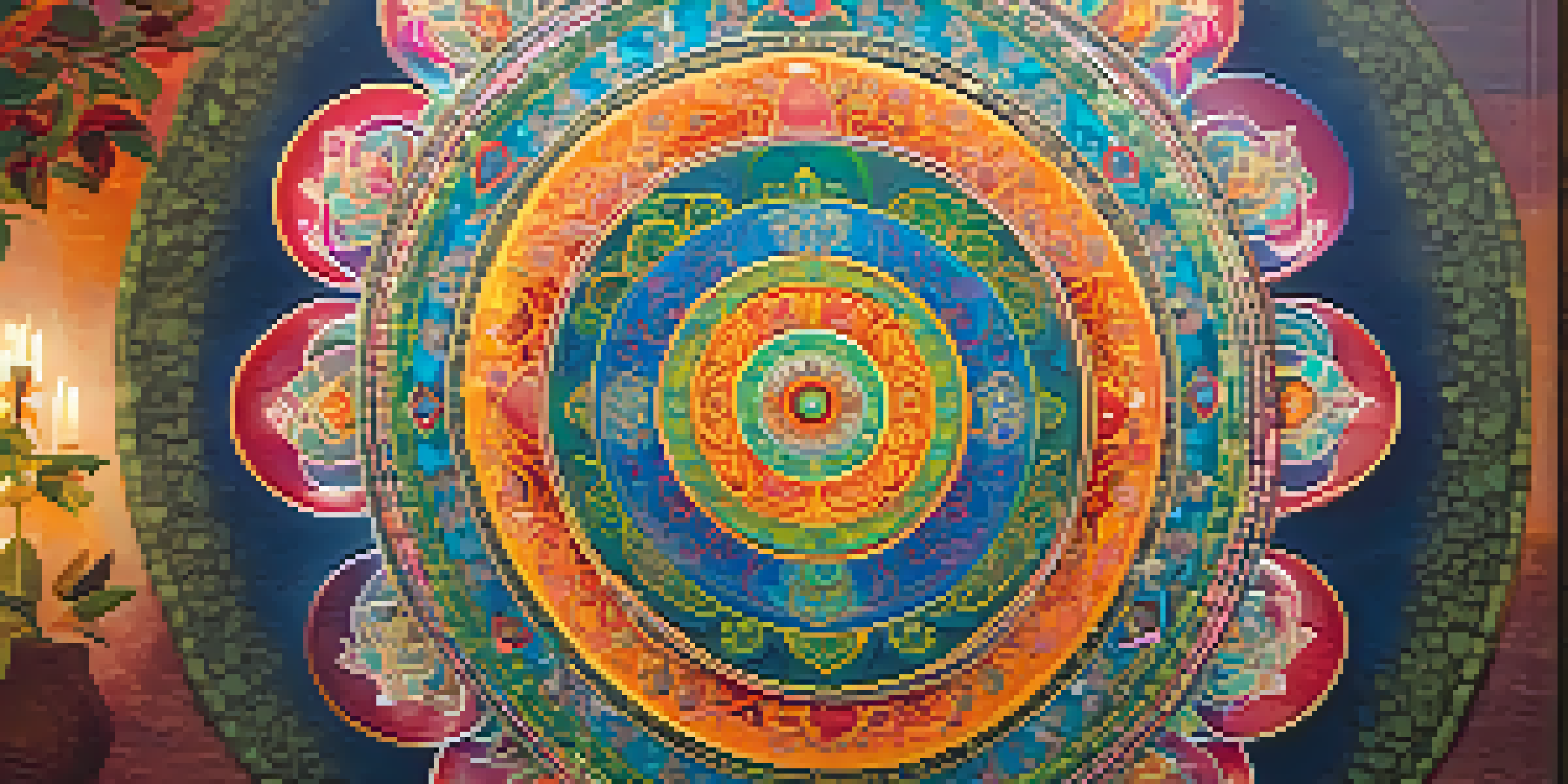Artistic Depictions of Spiritual Journeys in Various Cultures

The Role of Art in Spirituality Across Cultures
Art has long served as a bridge between the tangible and the spiritual. In many cultures, artistic expressions reflect beliefs, rituals, and the essence of the human experience. From ancient cave paintings to modern installations, art provides a visual language for spiritual exploration and connection.
Art enables us to find ourselves and lose ourselves at the same time.
For instance, the intricate mandalas of Tibetan Buddhism symbolize the universe and serve as tools for meditation. Each design element has profound meaning, guiding practitioners through their spiritual journeys. This illustrates how art can encapsulate complex ideas about life, death, and everything in between.
Moreover, through art, communities can share their spiritual narratives, fostering a sense of belonging and continuity. These artistic depictions allow individuals to connect with their heritage and reflect on their personal journeys within the broader context of their culture.
Indigenous Art and Spiritual Connection
Indigenous cultures around the world often intertwine art with their spiritual beliefs and practices. For example, Native American totems are not merely decorative; they encapsulate ancestral stories, spiritual teachings, and community values. Each carving represents a connection to the spirit world and the natural environment.

Similarly, Aboriginal Australian dot paintings tell stories of the Dreamtime, a sacred era that explains the creation of the world and its inhabitants. These artworks serve as maps of spiritual journeys, guiding individuals through their cultural landscapes and histories.
Art Bridges Spirituality and Culture
Across various cultures, art serves as a vital link between spiritual beliefs and community identity.
The use of natural materials and traditional techniques in Indigenous art underscores the deep respect for nature and the belief in interconnectedness. This artistic expression not only preserves spiritual narratives but also reinforces the community’s relationship with the land and its resources.
Eastern Philosophies and Artistic Representation
In Eastern cultures, spirituality often manifests through art forms like calligraphy, painting, and sculpture. For instance, Zen Buddhism emphasizes simplicity and mindfulness in artistic expression, encouraging practitioners to find beauty in everyday moments. The act of creating art becomes a meditative practice, a spiritual journey in itself.
The purpose of art is not a rarified, intellectual distillate; it is life, intensified, and transformed.
Chinese ink wash painting reflects the philosophy of harmony between humanity and nature. Artists use minimal strokes to convey profound emotions, inviting viewers to contemplate the essence of life. This approach illustrates how art can serve as a reflection of spiritual understanding and connection to the universe.
Additionally, the intricate designs of Hindu temples and the vibrant colors of festivals like Diwali are artistic expressions that embody spiritual beliefs. These visual elements create an immersive experience, inviting individuals to participate in the spiritual journey of their culture.
Christian Iconography and Spiritual Narratives
Christian art has played a significant role in conveying spiritual journeys and biblical narratives. From the stained glass windows of cathedrals to Renaissance paintings, these works often depict stories of faith, sacrifice, and redemption. They serve as visual reminders of spiritual teachings and the human experience.
For example, Michelangelo's 'The Creation of Adam' is not just a masterpiece of art; it symbolizes the divine connection between God and humanity. This depiction invites viewers to reflect on their own spiritual journeys and the quest for a relationship with the divine.
Indigenous Art and Spirituality Unite
Indigenous art forms intertwine spiritual narratives with cultural heritage, reinforcing connections to nature and ancestral beliefs.
Moreover, the use of symbols, like the cross or the fish, in Christian art helps convey complex spiritual concepts in a relatable manner. These artistic representations can inspire contemplation and foster a deeper understanding of one's faith and beliefs.
Ritualistic Art Forms in African Cultures
In many African cultures, art forms are integral to spiritual rituals and community identity. Masks, sculptures, and textiles often play a crucial role in ceremonies, representing ancestral spirits and cultural beliefs. These artworks are not only visually striking but also serve as conduits for spiritual connection and expression.
For example, the Dogon people of Mali create elaborate masks for their Dama ceremonies, which honor the deceased and facilitate their journey into the afterlife. Each mask embodies spiritual significance, allowing the community to engage with the spiritual world during important rituals.
Additionally, African beadwork often carries spiritual meanings, with colors and patterns symbolizing various aspects of life and spirituality. This artistic practice fosters a sense of unity and shared beliefs within the community, reinforcing the bond between art and spiritual journeys.
Contemporary Art and Personal Spiritual Exploration
In today’s world, contemporary artists are exploring spirituality through innovative and diverse mediums. Many use their art as a platform for personal reflection and to challenge societal norms. This shift allows for a more individualized approach to spiritual journeys, where personal experiences and beliefs take center stage.
For instance, artists like Yayoi Kusama use immersive installations to explore themes of infinity and connection to the universe. Her work invites viewers to reflect on their place within the cosmos, prompting an introspective journey that resonates on a personal level.
Contemporary Art Reflects Personal Journeys
Modern artists explore spirituality through innovative mediums, allowing for individualized expressions of personal beliefs and experiences.
This modern approach contrasts with traditional depictions, emphasizing the fluidity of spiritual journeys in contemporary society. Art becomes a means for individuals to share their unique stories and connect with others, fostering a broader understanding of spirituality in a diverse world.
The Impact of Art on Spiritual Awareness
Art has the power to elevate spiritual awareness, prompting individuals to reflect on their beliefs and experiences. Engaging with art can invoke emotions, provoke thought, and inspire a deeper understanding of one's spiritual journey. This connection often leads to personal growth and transformation.
For example, visiting an art exhibit that focuses on spirituality can create a space for contemplation and dialogue. Viewers may find themselves questioning their beliefs or seeking a deeper connection to their spirituality through the reflections evoked by the artwork.

Furthermore, communities that embrace artistic expressions of spirituality can foster collective healing and growth. Such environments encourage discussions about faith, personal journeys, and shared experiences, facilitating a supportive atmosphere for exploring spirituality.